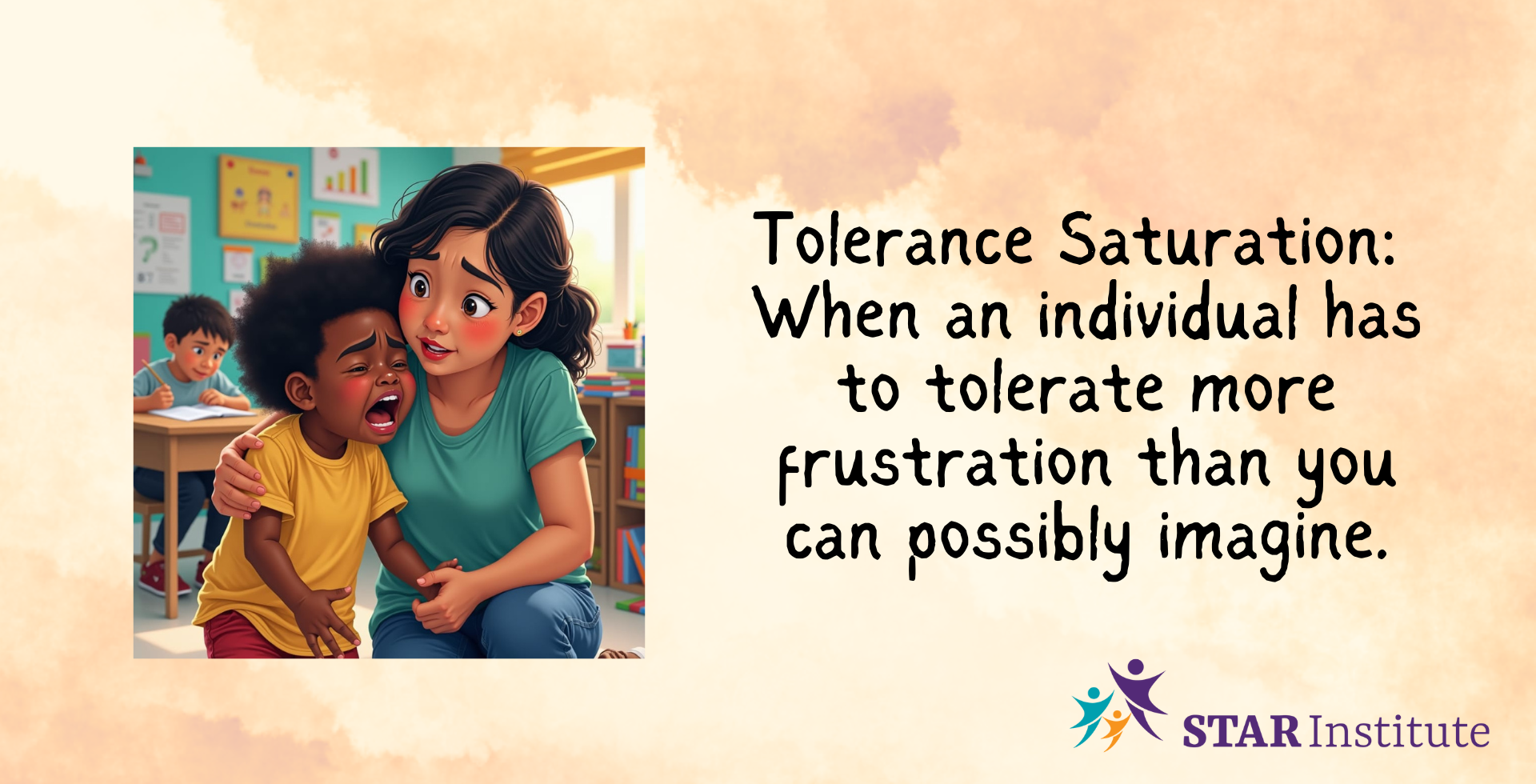Frustration Saturation

Frustration Saturation
Navigating the world presents unique challenges for neurodivergent individuals, shaped by a combination of biological (i.e., differences in sensory motor development), psychological (i.e., developmental trauma), and social factors (i.e, rigid and hostile environments). Daily tasks that others may find routine can be experienced as significant hurdles, demanding greater energy and effort than expected. This increased demand can result in what I refer to as "frustration saturation," where the ability to cope with frustration is depleted early and quickly. By recognizing this phenomenon we can better understand and support our neurodivergent clients, colleagues, and family members, creating a culture that fosters self-regulation and personal growth.
The Energy Expenditure of Daily Tasks
Frustration saturation occurs when an individual has expended a significant portion of their emotional and cognitive resources dealing with tasks that the external viewer may perceive as easy or mundane. Many neurodivergent individuals daily experiences of the world consist of: sensory overload; social misunderstandings; challenges with organization and navigation; and minute-by-minute pressure to conform to societal norms. Each of these challenges demands energy and attentional resources and—for the neurodivergent individual—the effort required to handle every-day tasks often leads to a rapid depletion of available resources.
Historically, society has often labeled this challenge as having a "low tolerance for frustration." This perspective is misleading and fails to recognize the underlying dynamics at play. Instead of simply being unable to cope, these individuals have already faced numerous frustrations throughout the day, leading to a state of exhaustion where they can no longer manage additional stressors.
Examples of Hidden Challenges
Consider the following scenarios:
- Sensory Discrimination: When I sense multiple stimuli but struggle to decipher their meanings, the world can feel overwhelmingly confusing and disorganized, leading to a sense of bombardment that heightens anxiety and makes it difficult to focus.
- Heightened Sensory Reactivity: Lights are experienced as brighter, flickering, and even noisy. Sounds are experienced as more suprising, intense, loud, base-filled, lingering for longer. Smells are more intense, triggering, distracting, upsetting. Touch is painful, confusing, disorganizing. The list goes on. The effort to filter out these stimuli commonly leads to rapid fatigue.
- Postural Immaturity: Maintaining posture during tasks can be challenging, leading to additional fatigue and distraction, further complicating the ability to focus and engage effectively.
- Dyspraxia: When faced with novel or multi-step tasks, I often experience difficulty coordinating my movements and organizing my thoughts, leading to challenges in executing the steps effectively. This can result in feelings of frustration and overwhelm, making it hard to complete tasks that require sequential processing or physical coordination.
- Aphantasia: The inability to visualize images in my mind makes it challenging to engage with concepts that rely on mental imagery, resulting in difficulties with tasks that require creative thinking or spatial awareness, often leaving me feeling disconnected from the material.
- Auditory Processing of Multiple-Step Directions: When faced with complex, multi-step instructions, I often struggle to process and retain the information simultaneously, leading to confusion and difficulty in following through, which can create a sense of frustration and overwhelm.
- Motor Disinhibition: This refers to a tendency for my body to act in ways that are not aligned with my conscious intentions, leading to involuntary movements or actions. It can create challenges in situations that require self-control, resulting in behaviors that may seem impulsive and are often interpreted as misbehavior.
- Routine Changes: Unexpected changes in routine can be particularly distressing. The mental energy required to adapt, especially when faced with difficulties in prediction, can lead to frustration and exhaustion.
- Task Initiation: Starting a task, whether it’s homework or household chores, can be a monumental hurdle. The mental block that often accompanies this can add can add layers of frustration, particularly for individuals with dyspraxia, who may struggle with motor planning and execution.
- Monotropism: When I become deeply engaged in a specific interest or task, I deeply enter an 'attention tunnel' and find it difficult to shift my attention to other stimuli or activities, making it challenging to respond to changes in my environment or to multitask effectively.
- Social Interactions: Engaging in conversations can be daunting, especially in neuronormative environments. The need to read social cues, manage sensory input, and respond appropriately can exhaust an individual’s energy reserves quickly.
- Attributing Poor Intent: Viewing differences like monotropism, dyspraxia, and motor disinhibition through an ableist lens often leads to stigmatization and misattribution of intent to these experiences. It can result in the perception that these traits are wilful misbehaviors rather than expressions of variable of human experience. This narrative reinforces barriers and limits opportunities for those who navigate these challenges. This adds further to the energy expenditure expected of neurodivergent community members and shames them for body based differences outside of their control.
Each of these situations compounds the individual’s overall energy expenditure, contributing to frustration saturation. When we recognize that our neurodivergent family members are working harder to navigate these challenges, we can develop more empathy and understanding for their behavior.

Reframing Our Perspective
To truly support our neurodivergent client's, peers, and family members, we need to shift our perspective from viewing frustration as a weakness to understanding it as a natural response to overwhelming circumstances. Here are some ways to reframe our understanding:
✅ Recognize the Effort: Acknowledge that neurodivergent individuals often exert more effort to complete tasks that may seem simple to others. This recognition can help validate their experiences.
✅ Offer Support: Instead of expressing frustration offer assistance. This could be as simple as breaking tasks into smaller, manageable steps or providing a quiet space to decompress.
✅ Create a Safe Environment: Minimize sensory overload in the home. This can involve dimming lights, reducing noise, or creating designated quiet spaces where they can retreat when feeling overwhelmed.
✅ Encourage Open Communication: Foster an environment where expression of frustrations and challenges is normal and welcomed. Sharing experiences and feelings can help in identifying patterns and triggers, engaging in shared social problem solving, and developing coping strategies.
✅ Practice Patience: Frustration saturation is what happens when an individual has been pushed past their limit and can lead to emotional outbursts or withdrawal. Approach these moments with compassion and empathy, they are the result of overwhelming circumstances rather than intentional behavior.
Strategies for Managing Frustration Saturation
Here are some practical strategies that can help neurodivergent individuals manage frustration saturation:
- Encourage regular breaks throughout the day. Short periods of rest can help recharge their emotional and cognitive resources.
- Trial self-regulation and mindfulness techniques. Find out what is nourishing for this brain-body at this time and be open to that changing over time, as seasons and weather change, and daily depending on sleep, hydration, and other differences.
- Increase predictability. Use schedules, visual schedules or checklists to help with task and day navigation. Aim to provide clarity and reduce anxiety about what comes next.
- Celebrate accomplishment and efforts, no matter how minor. Avoid generic phrases like "good job" and incentive based positive reinforcement and opt instead for meaningful recognition of hard-work, teamwork, and self- and community-actualization.
- Develop Coping Mechanisms: Work together to identify a buffet of effective coping strategies, whether it’s engaging in regular and regulating leisure occupation, using fidget tools, using accommodations, accessing social supports, or practicing grounding techniques.
- Apply 'Spoon Theory' at home. Watch this space for a blog on how to use spoon theory as a family!
What does this mean for goal setting and IEP development?
Away with the "increasing tolerance for frustration" goals!
-
Personalized Goals: Tailor goals to the individual's unique strengths and challenges, acknowledging their specific experiences with frustration saturation and energy expenditure.
-
Realistic Expectations: Set achievable targets that account for the extra effort neurodivergent individuals may need to complete tasks that others find simple.
-
Supportive Strategies: Incorporate strategies that help manage fatigue and overload, and promote self-regulation, such as breaks and/or sensory accommodations.
-
Collaboration: Involve, educate, and collaborate with the individual, their family, and relevant professionals in the goal-setting process to ensure that goals reflect their needs and preferences.
-
Flexible Approaches: Allow for adjustments in goals and methods based on the individual's progress and changing circumstances, recognizing that their needs may evolve over time and change from day to day.
-
Focus on Strengths: Highlight and build upon the individual’s strengths and interests, fostering engagement and motivation in their learning process.
By integrating these considerations, IEPs can better support neurodivergent individuals in achieving their educational goals while respecting their unique experiences.
TL;DR: Neurodivergent individuals face unique challenges in daily tasks due to biological, psychological, and social factors, leading to "frustration saturation," where emotional and cognitive resources are quickly depleted. This is often misinterpreted as a low tolerance for frustration. Examples of hidden challenges include sensory overload, dyspraxia, and motor disinhibition. To support neurodivergent individuals, it's essential to recognize their efforts, offer assistance, create safe environments, encourage open communication, and practice patience. Strategies like regular breaks, mindfulness, and clear schedules can help manage frustration saturation and foster understanding and empathy.
